
Ratnakara as it is called in Sanskrit which means ‘the maker of gems’, the Indian Ocean is the world’s third largest ocean named after the country India in the Asian sub-continent. It comprises of approximately, 20 percent of earth’s water.
The Indian Ocean has India, Iran, Pakistan and Bangladesh in the north; the Malay Peninsula, the Sunda Islands of Indonesia and Australia run across the eastern coast; Antarctica lies in the southern part; and Africa and the Arabian Peninsula to the west. The longest stretch of the ocean is more than 9,900km from the southern tips of Africa to Australia. It joins the Atlantic Ocean in the southwest and meets the Pacific Ocean in the southeast.
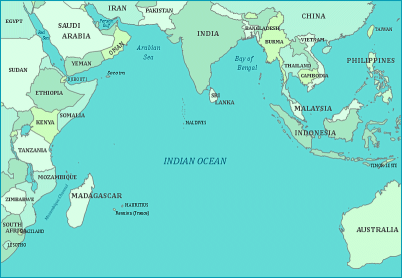
The Indian Ocean is so vast that it encompasses a total area of 68,556sq.km. The coastline extends for a length of 66,526km. The ocean has an average depth of 3,960 metres and its deepest point lies 7,450 metres below the sea level in the Sunda Deep off the Java Trench. Apart from having the deepest point of Indian Ocean, Java Trench is also the world’s second longest trench with a width of 80 km and stretching for more than 4,500km. It is a narrow but prone to volcanic eruptions and earthquakes.
The Indian Ocean has four major access waterways. They are; the Suez Canal (Egypt), Bab el Mandeb (Djibouti-Yemen), Strait of Hormuz (Iran-Oman) and Strait of Malacca (Indonesia-Malaysia).
Another important feature of the Indian Ocean is its ridges. One of the significant ridges is the Ninety East Ridge which is an earthquake-free underwater mountain range. It is also the longest and straightest of all the ridges in the world ocean. It was first discovered in the year 1962 and it runs from the Broken Ridge, in the west of Australia, and extends for nearly 2,800 miles till the sediments underneath the Bay of Bengal.
Another important ridge is the Mid-Oceanic Ridge that divides the ocean into three divisions. This broad submarine mountain extends from Asia to Antarctica in the shape of a ‘Y’ and forms the sections known as African, Antardis and the Australasian. It has an average height of nearly 3000 metres and at some places it even rises above the sea level and forms islands.
The dominating feature of the currents of Indian Ocean is the Indian Ocean gyre (gyre is a semi closed current system exhibiting spiral motion). The current reverses its direction in every half year. During the northeast monsoon, a counter clockwise gyre develops in the Arabian Sea and a clockwise gyre in the Bay of Bengal. Both the currents reverse its direction during the southwest monsoon. The westward flowing North Equatorial Current from the south of Sri Lanka turns south at the coast of Somalia and moves eastward between 2° S and 10° S. This same current becomes east-flowing Monsoon Current during southwest monsoon. At this time there is also the South Equatorial Current that turns north at the coast of Somalia and becomes the Somali Current at the 10°S.
The South Equatorial Current flows westward between 10° S and 20° S which gets divided once it reaches Madagascar. One branch of the current turns south and becomes the Mozambique Current flowing between Africa and Madagascar. It then gains its speed up to 95 km/h and by the time it reaches South Africa, it is known as Agulhas Current. The current then turns east and joins the Antarctic Circumpolar Current that travels southwards from 45° S. The other branch of the current flows south to the east of Madagascar till 40° S to 45° S and then it takes a turn towards the east and becomes the South Indian Current.
The gyre is closed, to a certain extent, by the West Australian Current that flows north from the South Indian Current. Out of all the currents, only the Antarctic Circumpolar Current reaches the ocean floor, the Agulhas Current and the Somali Current are able to penetrate till a depth of nearly 1,200 metres and 800 metres respectively. Most of the other currents do not even go below 300 metres.
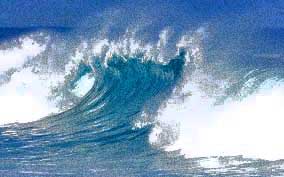
The Seychelles and the Kerguelen Islands are some of the islands formed by the underwater ridges that rise above the water. Compared to other oceans the Indian Ocean has lesser number of islands. To name a few, there is the fourth largest island, Madagascar, Sri Lanka, Maldives, Socotra etc. And islands of volcanic origin, such as Mauritius, Reunion, Andaman and Nicobar, Cocos etc.
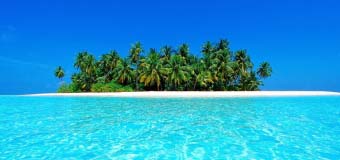
The Indian Ocean is the warmest ocean with a surface water temperature that differs depending on the latitudes. During summer and towards the north of 20°S, the Indian Ocean attains a maximum temperature of 28°C in the Bay of Bengal whereas the minimum temperature is recorded to be 22°C in the area of Cape Gwardafuy. On the other hand the southern zone from the latitude of 20°S has surface water whose temperature decreases with the increase in latitude, from a maximum of 22 to 24°C to -1°C near the Antarctica. During winter, the water surface has a temperature of about 22 to 23°C in the Arabian Sea and 25°C in the Bay of Bengal.
The Indian Ocean has an average surface water salinity ranging from 32 to 37 grams of salt in 1000 grams of water. The Red Sea has an average salinity of 40 grams of salt in 1000 grams of water and Bay of Bengal has a lesser salinity of less than 32 grams of salt in 1000 grams of water which is due to the drainage of fresh water from rivers.
Like any other ocean, the Indian Ocean also has a marine life comprising of different species. Out of all the animals that live here, some of the species unique to this ocean are:
Great White Shark: This is a huge animal and also the largest predatory fish on earth. The shark is more than 4.6 metres in length and weighs even more than 2,268kg. Universally, they all have a white underbelly and thus they are named so. They have a streamlined torpedo-shaped body with tails that enable them to become powerful swimmers and can travel under water at speeds up to 24 km/h. These Great White Sharks can track down a drop of blood in 100 litres of water and can also sense a small amount of blood even at a distance of 5 km. They attack humans more than any other sharks but people have survived. It’s all because they don’t like the taste of humans. Instead, they live mostly on sea lions, small toothed whales, sea turtles and seals.
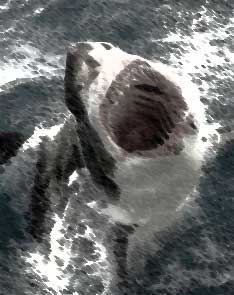
Green Sea Turtle: The Green Sea Turtle is a very large sea turtle weighing nearly 317.5 kg and has a length of 1.5 metre. It has a smooth brown or olive coloured shell depending on its habitat and it has greenish skin because of which it is named so. But the irony is that, despite being sea turtles, they cannot pull their heads inside their shells. The adult ones are herbivorous and live on sea grasses and algae while the young ones eat crabs, jellyfish and sponges.
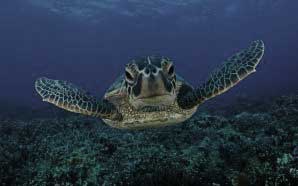
Dugong: Also known as ‘sea cows’, Dugongs are large, grey coloured mammals which are 2.4 to 3 metre long with a weight of 231 to 499kg. The reason why they are called sea cows is that they keep on grazing on underwater grasses day and night. They have a bristled, sensitive snouts and rough lips. They also have quite a strong tail upon which they manage to stand and breathe with their heads above water after a six-minute stay underwater. They usually gather in herds of thousands, but they mostly prefer to stay alone or in pairs. The mother dugongs give birth to an infant after a year of pregnancy. She carries the youngling on her broad back around the ocean and the young ones also remain close to their mothers for about 18 months.
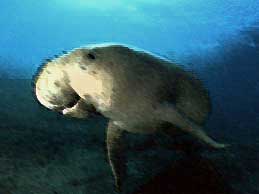
Bottlenose Dolphin: Its intelligence and charisma have been a major attraction. These Bottlenose dolphins are 3 to 4.2 metres long and weigh up to 500kg. They can splash out of the water up to a height of 4.9 metres and land on their back or sides. They often come to the surface to breathe and they do it every two or three minutes. These are also fast swimmers reaching up to a speeds of 30 km/h. They travel together in groups and communicate with each other through squeaks and whistles. They are capable of making more than 1000 clicking noises that would travel underwater detecting the presence of an object. Once these sounds encounter an object, they bounce back to the sender and that’s how a dolphin can figure out the location, shape and size of the object.
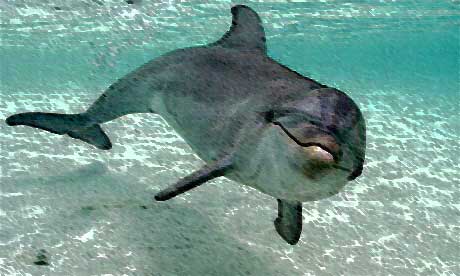
Since it doesn’t share its boundary with any other landmass other than Antarctica, it has lots of seas, bays and gulfs at its marginal areas. The marginal seas are:
- Arabian Sea
- Bay of Bengal
- Andaman Sea
- Red Sea, which is the saltiest open sea in the world.
- Java Sea
- Persian Gulf, the warmest sea in the world.
- Sea of Zanj
Apart from these seas, the other main water bodies at its extremities are: Gulf of Oman, Strait of Bab-el-Mandeb, Gulf of Kutch, Gulf of Khambat, Palk Strait, Malacca Strait, Madagascar Strait, Great Australian Bight and Gulf of Munnar.


